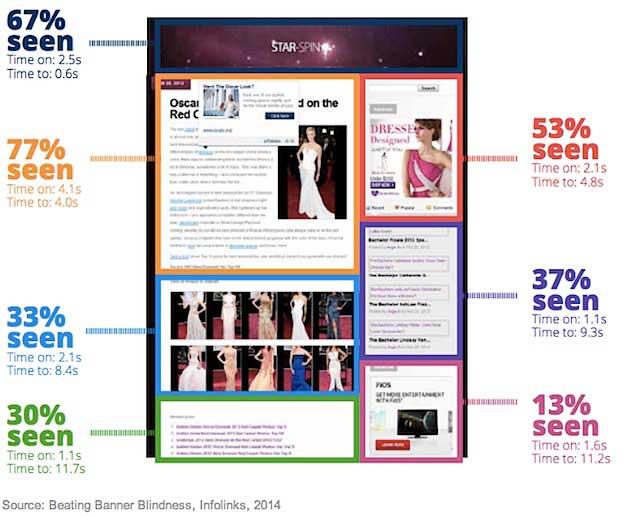Eye-Tracking Study: How to Beat Display Ad Blindness
by Ayaz Nanji
Advertisers looking to boost the effectiveness of their digital display ads should be focusing on in-content units, nontraditional placements, contextually relevant creative, and above-the-fold locations, according to recent data from Infolinks.
The report was based on the results of an eye tracking study conducted by EyeTrackShop in 2013. Participants allowed researchers to access their webcams, which were then calibrated to track eye movements as webpages were viewed. Almost all of the respondents were under 40 (76% 18-30; 22% 31-40), and half were male, half female.
Below, key findings from the study.
Native Ads vs. Banner Ads
- Native ads—units delivered within core content areas—were seen 47% more quickly than banner ads in traditional locations on the same pages.
- Moreover, the time spent in the main content areas was 4,000% more than the time spent in the areas containing the banner ads, resulting in significantly higher brand recall.

Above the Fold
- Infolinks found conventional wisdom holds true: The top content area of a webpage (above the fold) does function significantly better than the bottom content area (below the fold) in terms of visibility ratio, time spent, and time to notice.
- In the study, 156% more people saw the top content area of the page compared with the bottom content area.
- However, being at the very top of the screen, where leaderboard ads are often placed, is not always beneficial. An ad unit at the bottom of the screen, just above the fold, was seen 225% more quickly than standard leaderboard ads at the top of the page—suggesting that users were skipping over the leaderboard placement, anticipating its irrelevance.
→ end article preview
Read the Full Article
- Testemunhos
-
“ADSO= Inovação e Competência. Mais que um fornecedor de serviços são parceiros estratégicos.” Filipe Silva – FAFstone
-
“Pela seriedade, profissionalismo e empenho! Sabe "vestir" a nossa camisola!” António Ressurreição


